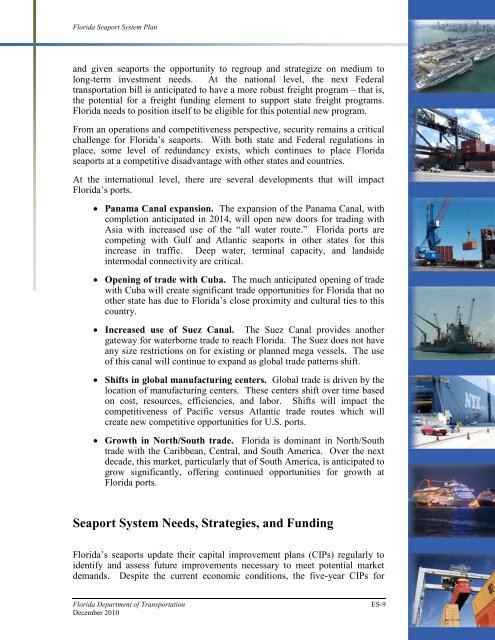Florida Seaport System Plan - SeaCIP
Florida Seaport System Plan - SeaCIP
Florida Seaport System Plan - SeaCIP
Create successful ePaper yourself
Turn your PDF publications into a flip-book with our unique Google optimized e-Paper software.
<strong>Florida</strong> <strong>Seaport</strong> <strong>System</strong> <strong>Plan</strong><br />
and given seaports the opportunity to regroup and strategize on medium to<br />
long-term investment needs. At the national level, the next Federal<br />
transportation bill is anticipated to have a more robust freight program – that is,<br />
the potential for a freight funding element to support state freight programs.<br />
<strong>Florida</strong> needs to position itself to be eligible for this potential new program.<br />
From an operations and competitiveness perspective, security remains a critical<br />
challenge for <strong>Florida</strong>’s seaports. With both state and Federal regulations in<br />
place, some level of redundancy exists, which continues to place <strong>Florida</strong><br />
seaports at a competitive disadvantage with other states and countries.<br />
At the international level, there are several developments that will impact<br />
<strong>Florida</strong>’s ports.<br />
• Panama Canal expansion. The expansion of the Panama Canal, with<br />
completion anticipated in 2014, will open new doors for trading with<br />
Asia with increased use of the “all water route.” <strong>Florida</strong> ports are<br />
competing with Gulf and Atlantic seaports in other states for this<br />
increase in traffic. Deep water, terminal capacity, and landside<br />
intermodal connectivity are critical.<br />
• Opening of trade with Cuba. The much anticipated opening of trade<br />
with Cuba will create significant trade opportunities for <strong>Florida</strong> that no<br />
other state has due to <strong>Florida</strong>’s close proximity and cultural ties to this<br />
country.<br />
• Increased use of Suez Canal. The Suez Canal provides another<br />
gateway for waterborne trade to reach <strong>Florida</strong>. The Suez does not have<br />
any size restrictions on for existing or planned mega vessels. The use<br />
of this canal will continue to expand as global trade patterns shift.<br />
• Shifts in global manufacturing centers. Global trade is driven by the<br />
location of manufacturing centers. These centers shift over time based<br />
on cost, resources, efficiencies, and labor. Shifts will impact the<br />
competitiveness of Pacific versus Atlantic trade routes which will<br />
create new competitive opportunities for U.S. ports.<br />
• Growth in North/South trade. <strong>Florida</strong> is dominant in North/South<br />
trade with the Caribbean, Central, and South America. Over the next<br />
decade, this market, particularly that of South America, is anticipated to<br />
grow significantly, offering continued opportunities for growth at<br />
<strong>Florida</strong> ports.<br />
<strong>Seaport</strong> <strong>System</strong> Needs, Strategies, and Funding<br />
<strong>Florida</strong>’s seaports update their capital improvement plans (CIPs) regularly to<br />
identify and assess future improvements necessary to meet potential market<br />
demands. Despite the current economic conditions, the five-year CIPs for<br />
<strong>Florida</strong> Department of Transportation<br />
December 2010<br />
ES-9
















